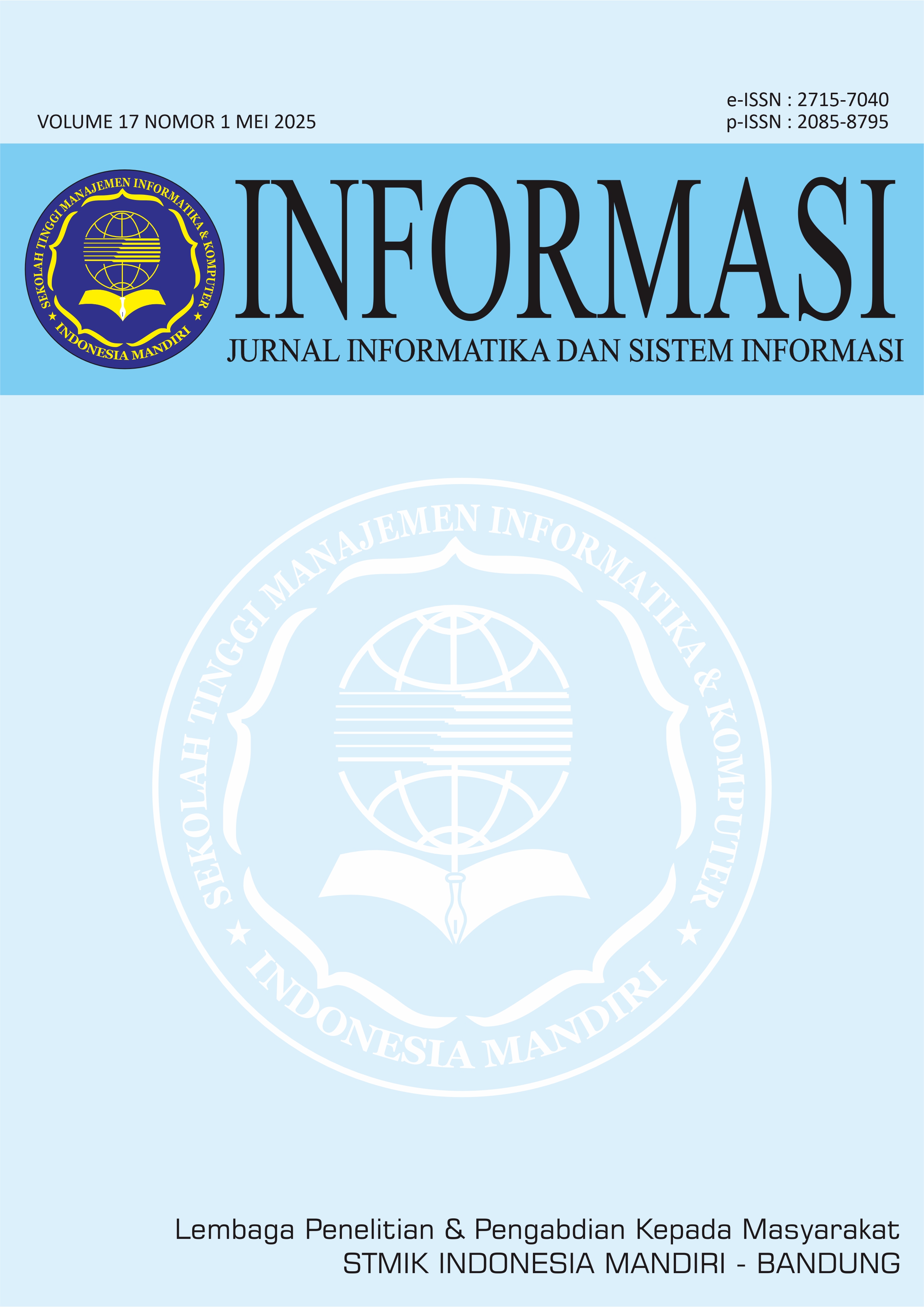Evaluasi Penerimaan Pengguna Aplikasi Kebugaran Smartphone Menggunakan UTAUT2
Abstract
Digitalisasi telah menciptakan perubahan besar pada berbagai aspek, tak terkecuali dalam bidang kebugaran dan kesehatan. Aplikasi kebugaran berbasis smartphone semakin banyak digunakan sebagai sarana untuk membantu individu dalam mengelola aktivitas fisik dan kesehatan. Peningkatan kesadaran akan pentingnya gaya hidup sehat turut mendorong pertumbuhan penggunaan aplikasi kebugaran. Namun, tingkat retensi pengguna aplikasi kebugaran masih rendah, lebih dari 75% pengguna berhenti menggunakan aplikasi sejak hari pertama penggunaan. Kemudian masih banyak keluhan pengguna yang menjadi tantangan dalam penerimaan aplikasi kebugaran. Tujuan penelitian ini yakni mengevaluasi faktor yang mempengaruhi niat pengguna aplikasi kebugaran dengan model UTAUT2. Penelitian ini menggunakan metode survei kuantitatif dengan teknik SEM-PLS yang diolah menggunakan perangkat lunak SmartPLS 4. Sebanyak 427 responden berhasil dikumpulkan melalui survei daring yang merupakan pengguna aplikasi kebugaran di kota Surabaya, Indonesia. Hasil penelitian ini menunjukkan bahwa performance expectancy, facilitating conditions, hedonic motivation, price value, dan habit berpengaruh signifikan terhadap niat pengguna dalam menggunakan aplikasi kebugaran, sementara effort expectancy dan social influence tidak menunjukkan pengaruh signifikan. Habit merupakan faktor dominan dengan nilai path coefficient sebesar 0.317, yang menunjukkan bahwa kebiasaan merupakan faktor utama dalam mendorong penggunaan aplikasi kebugaran. Oleh karena itu, pengembang aplikasi disarankan untuk mengintegrasikan fitur gamifikasi, pengingat otomatis, serta program loyalitas yang dapat membentuk kebiasaan penggunaan aplikasi secara berkelanjutan.
References
Aripradono, H. W. (2021). Analisis Technology Readiness and Acceptance Model (TRAM) Pada Penggunaan Sport Wearable Technology. Teknika, 10(1), 68–
https://doi.org/10.34148/teknika.v10i1.330
Barkley, J. E., Lepp, A., Santo, A., Glickman, E., & Dowdell, B. (2020). The relationship between fitness app use and physical activity behavior is mediated by exercise identity. Computers in Human Behavior, 108(September 2019), 106313. https://doi.org/10.1016/j.chb.2020.106313
Beh, P. K., Ganesan, Y., Iranmanesh, M., & Foroughi, B. (2021). Using smartwatches for fitness and health monitoring: the UTAUT2 combined with threat appraisal as moderators. Behaviour and Information Technology, 40(3), 282–299. https://doi.org/10.1080/0144929X.2019.1685597
Bianchi, C., Tuzovic, S., & Kuppelwieser, V. G. (2023). Investigating the drivers of wearable technology adoption for healthcare in South America. Information Technology and People, 36(2), 916–939. https://doi.org/10.1108/ITP-01-2021-0049
Chin, W. W. (1998). The Partial Least Squares Approach to Structural Equation Modeling. In G. A. Marcoulides (Ed.), Modern Methods for Business Research (pp. 295–336). Lawrence Erlbaum Associates.
Cholik, C. A. (2021). Perkembangan Teknologi Informasi Komunikasi / ICT Dalam Berbagai Bidang. Jurnal Fakultas Teknik, 2(2), 39–46.
Dahiya, H., & Saini, A. K. (2024). Assessing individuals’ attitude and behavioural intention to use dietary and fitness mobile applications: evidence from India. Journal of Indian Business Research, 16(3), 329–352. https://doi.org/10.1108/JIBR-12-2022-0302
Damberg, S. (2022). Predicting future use intention of fitness apps among fitness app users in the United Kingdom: the role of health consciousness. International Journal of Sports Marketing and Sponsorship, 23(2), 369–384. https://doi.org/10.1108/IJSMS-01-2021-0013
Darman, & Mooduto, W. I. S. (2018). Statistik Penelitian: Pendekatan Praktis Menggunakan SPSS dan SmartPLS. In Nas Media Pustaka.
Dhiman, N., Arora, N., Dogra, N., & Gupta, A. (2020). Consumer adoption of smartphone fitness apps: an extended UTAUT2 perspective. Journal of Indian Business Research, 12(3), 363–388. https://doi.org/10.1108/JIBR-05-2018-0158
Faroqi, A., Apol Pribadi, S., & Tri Lathif, M. S. (2020). Exploring Online Shoppers’ Acceptance of Electronic Marketplace Using UTAUT and the Flow Theory. Journal of Physics: Conference Series, 1569(2). https://doi.org/10.1088/1742- 6596/1569/2/022051
Faroqi, A., Suryanto, T. L. M., & Safitri, E. M. (2020). The Determinant of E- Government Services Adoption among Citizen in Indonesia. 2020 6th Information Technology International Seminar (ITIS), 130–134. https://doi.org/10.1109/ITIS50118.2020.9321068.
Ferreira Barbosa, H., García-Fernández, J., Pedragosa, V., & Cepeda-Carrion, G. (2022). The use of fitness centre apps and its relation to customer satisfaction: a UTAUT2 perspective. International Journal of Sports Marketing and Sponsorship, 23(5), 966–985. https://doi.org/10.1108/IJSMS-01-2021-0010
Ghozali, I., & Latan, H. (2015). Partial Least Squares Konsep Teknik dan Aplikasi dengan Program Smart PLS 3.0 Untuk Penelitian Empiris (2nd ed.). BP Undip.
Goyal, J., & Rakhra, G. (2024). Sedentarism and Chronic Health Problems. Korean Journal of Family Medicine, 45(5), 239–257. https://doi.org/10.4082/kjfm.24.0099
Guo, J. (2022). Influencing Factors of College Students’ Use of Sports Apps in Mandatory Situations: Based on UTAUT and SDT. BioMed Research International, 2022. https://doi.org/10.1155/2022/9378860
Hair, Jr., J. F., M. Hult, G. T., M. Ringle, C., Sarstedt, & Marko. (2022). A Primer on Partial Least Squares Structural Equation Modeling (PLS-SEM) [3 ed]. In Sage Publishing (Vol. 3, Issue 1).
Huang, C. Y., & Yang, M. C. (2020). Empirical investigation of factors influencing consumer intention to use an artificial intelligence-powered mobile application for weight loss and health management. Telemedicine and E-Health, 26(10), 1240–1251. https://doi.org/10.1089/tmj.2019.0182
Kalgotra, P., Raja, U., & Sharda, R. (2022). Growth in the development of health and fitness mobile apps amid COVID-19 pandemic. Digital Health, 8. https://doi.org/10.1177/20552076221129070
Kim, B., & Lee, E. (2022). What Factors Affect a User’s Intention to Use Fitness Applications? The Moderating Effect of Health Status: A Cross-Sectional Study. Inquiry (United States), 59, 1–13. https://doi.org/10.1177/00469580221095826
Kumareswaran, S. (2023). Detrimental Impact of Sedentary Behaviour on Health. European Journal of Medical and Health Sciences, 5(1), 18–22. https://doi.org/10.24018/ejmed.2023.5.1.1630
Schretzlmaier, P., Hecker, A., & Ammenwerth, E. (2022). Suitability of the Unified Theory of Acceptance and Use of Technology 2 Model for Predicting mHealth Acceptance Using Diabetes as an Example: Qualitative Methods Triangulation Study. JMIR Human Factors, 9(1). https://doi.org/10.2196/34918
Stults-Kolehmainen, M. A. (2023). Humans have a basic physical and psychological need to move the body: Physical activity as a primary drive. Frontiers in Psychology, 14(April), 1–16. https://doi.org/10.3389/fpsyg.2023.1134049
Suryanto, T. L. M., Wulansari, A., Amalia, I. S., Mukaromah, S., Ridwandono, D., & Hadiwiyanti, R. (2023). Influencing Factor User Acceptance Mobile Library in Indonesia: A Study on iPusnas Application. 2023 IEEE 9th Information Technology International Seminar (ITIS), 1–6. https://doi.org/10.1109/ITIS59651.2023.10420411.
Utomo, P., Kurniasari, F., & Purnamaningsih, P. (2021). The Effects of Performance Expectancy, Effort Expectancy, Facilitating Condition, and Habit on Behavior Intention in Using Mobile Healthcare Application. International Journal of Community Service & Engagement, 2(4), 183–197. https://doi.org/10.47747/ijcse.v2i4.529
Venkatesh, V., Thong, J. Y. L., & Xu, X. (2012). Consumer Acceptance And Use Of Information Technology: Extending The Unified Theory Of Acceptance And Use Of Technology. MIS Quarterly, 36(1), 157–178.
Wei, J., Vinnikova, A., Lu, L., & Xu, J. (2021). Understanding and Predicting the Adoption of Fitness Mobile Apps: Evidence from China. Health Communication, 36(8), 950–961. https://doi.org/10.1080/10410236.2020.1724637
Yang, Y., & Koenigstorfer, J. (2021). Determinants of fitness app usage and moderating impacts of education-, motivation-, and gamification-related app features on physical activity intentions: Cross-sectional survey study. Journal of Medical Internet Research, 23(7). https://doi.org/10.2196/26063
Yuan, S., Ma, W., Kanthawala, S., & Peng, W. (2015). Keep Using My Health Apps: Discover Users’ Perception of Health and Fitness Apps with the UTAUT2 Model. Telemedicine and E-Health, 21(9), 735–741. https://doi.org/10.1089/tmj.2014.0148
Yuliana, P. D., & Aprianingsih, A. (2022). Factors involved in adopting mobile banking for Sharia Banking Sector using UTAUT 2. Jurnal Keuangan Dan Perbankan, 26(1), 184–207. https://doi.org/10.26905/jkdp.v26i1.6858
Copyright (c) 2025 INFORMASI (Jurnal Informatika dan Sistem Informasi)

This work is licensed under a Creative Commons Attribution 4.0 International License.
Tanggung jawab Penulis
- Penulis menyajikan artikel penelitian atau hasil pemikiran secara jelas, jujur, dan tanpa plagiarisme.
- Penulis harus menunjukkan rujukan dari pendapat dan karya orang lain yang dikutip.
- Penulis bertanggungjawab atas konfirmasi yang diajukan atas artikel yang telah ditulis.
- Penulis harus menulis artikel secara etis, jujur, dan bertanggungjawab, sesuai dengan peraturan penulisan ilmiah yang berlaku.
- Penulis tidak keberatan jika artikel mengalami penyuntingan tanpa mengubah substansi












